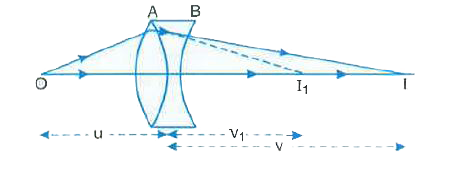A converging lens of focal length f1 is placed coaxially in contact with a diverging lens of focal length f2((f1>f2). Determine the power and nature of the combination in terms of f1 and f2.
Consider two thin lenses A and B of focal lengths f1 and f2 placed in contact. Let a point object be placed at O, beyond the focus of first lens A. Lens A forms a real image at I1. This image serves as a virtual object for second lens B and the final real image is formed at I.
For image I1 formed by first lens, we have
1v1−1u=1f1
and for the image I formed by the second lens, we have
1v−1v1−1f2 ...(ii)
Adding (i) and (ii), we have
1v−1u=1f1+1f2 ...(iii)

If the two lens system is considered as equivalent to a single lens of focal length f, then
1v−1u=1f ..(iv)
Comparing (iii) and (iv), we get
1f=1f1+1f2 or P=P1+P2
As 1st lens is converging one but 2nd lens is diverging, hence f1 is +ve but /2 is -ve and moreover f1>f2.
∴P=P1+P2=1f1+1(−f2)=f1−f2f1f2=−ve, i.e. the combination behaves as a diverging lens.
Topper's Solved these Questions
- EXAMINATION PAPER 2020 (SOLVED)BOOK - U-LIKE SERIESCHAPTER - EXAMINATION PAPER 2020 (SOLVED)EXERCISE - SECTION C
8 Videos
- EXAMINATION PAPER 2020 (SOLVED)BOOK - U-LIKE SERIESCHAPTER - EXAMINATION PAPER 2020 (SOLVED)EXERCISE - SECTION D
6 Videos
- EXAMINATION PAPER 2020 (SOLVED)BOOK - U-LIKE SERIESCHAPTER - EXAMINATION PAPER 2020 (SOLVED)EXERCISE - SECTION D
6 Videos
- ELECTROSTATIC POTENTIAL AND CAPACITANCE BOOK - U-LIKE SERIESCHAPTER - ELECTROSTATIC POTENTIAL AND CAPACITANCE EXERCISE - SELF ASSESSMENT TEST
1 Videos
- MAGNETISM AND MATTERBOOK - U-LIKE SERIESCHAPTER - MAGNETISM AND MATTEREXERCISE - SELF ASSESSMENT TEST (Section D)
1 Videos
Similar Questions
A convex lens of focal length 30 cm is placed coaxially in contact with a concave lens of focal length 40 cm. Determine the power of the combination. Will the system be converging or diverging in nature?
View SolutionA convex lens of focal length 25 cm is placed coaxially in contact with a concave lens of focal length 20 cm. Determine the power of the combination. Will the system be converging or diverging in nature ?
View Solution
Knowledge Check
Two thin lenses of focal lengths f1 and f2 are in contact. The focal length of this combination is
Af1f2f1−f2Bf1f2f1+f2C2f1f2f1−f2D2f1f2f1+f2Two thin lenses of focal length f1 and f2 are in contact and coaxial. The power of the combination is
A√f1f2B√f2f1Cf1+f2f1f2Df1+f2f1f2Two thin lenses of focal lengths f1andf2 are in contact and conxial. The power of the combination is
Af1+f2f1f2B√f1f2C√f2f1Df1+f22
A convex lens of focal length 30 cm is placed coaxially in contact with a concave lens of focal length 40 cm. Determine the power of the combination. Will the system be converging or diverging in nature?
View SolutionA convex lens of focal length f1 is kept in contact with a concave lens of focal length f2. Find the focal length of the combination.
View SolutionA convex lens of focal length f1 is kept in contact with a concave lens of focal length f2. Find the focal length of the combination.
View SolutionTwo thin lenses of focal lengths f1 and f2 are in contact. The focal length of this combination is
View SolutionTwo thin lenses of focal length f1 and f2 are in contact and coaxial. The power of the combination is
View Solution
